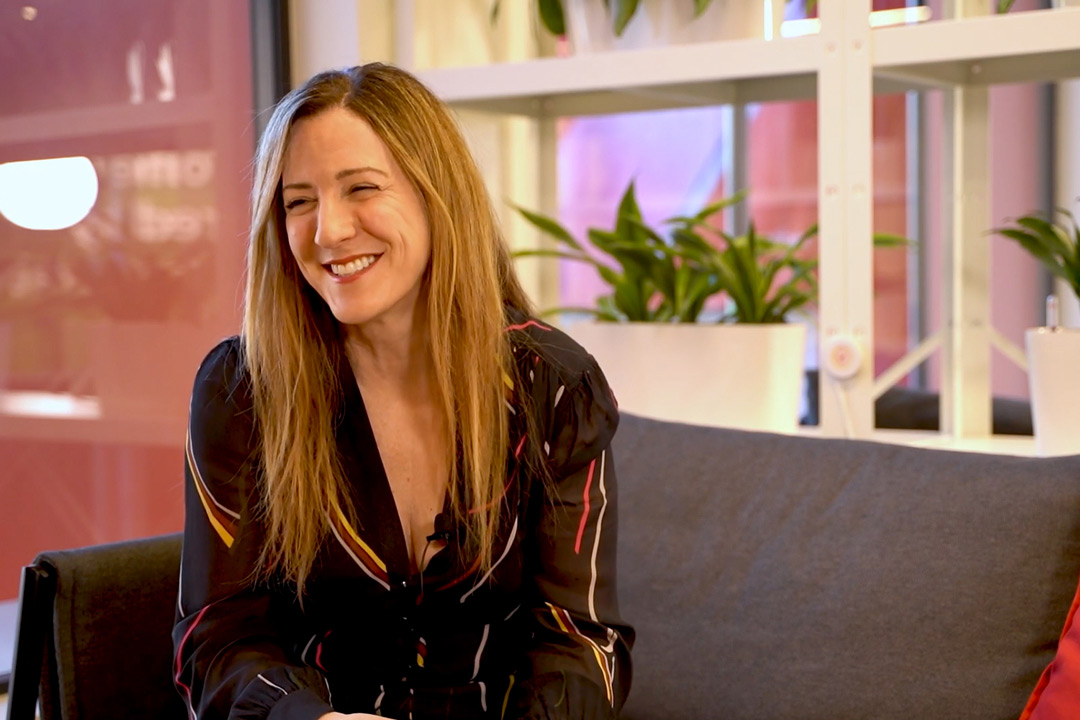From pronouns to transitioning, here parents and experts discuss the best ways to talk - and listen - when navigating the subject of gender identity with young people.
“Before my daughter Chazzie came out to my wife and me when she was nine, we hadn’t actually ever met anyone who was a transgender young person,” says John Grosshandler.
“We didn’t understand the correct terms to use, or why pronouns were important, for example.”
The parents began searching for positive stories about trans and non-binary kids to support Chazzie, but returned empty handed. Undeterred, they started GenderCool, a project dedicated to helping grown-ups and the kids in their lives understand that “transgender and non-binary youth are just like all other kids”.
“We quickly became very knowledgeable about all the important topics relevant to supporting a transgender child, because we knew it was required to provide her the best support on her journey,” says John.
Chazzie is now a happy 15-year-old girl, but plenty of parents and young people still struggle to find the right words to talk about gender identities. So GenderCool has now launched a series of books, each called A Kid’s book About… covering ‘being inclusive’, ‘being non-binary’ and ‘being transgender’.
The Grosshandlers, in other words, have become expert at helping their child and others explore and understand an issue that sometimes feels red hot. The good news is, it boils down to being kind, says John.
As the UK-based charity Gendered Intelligence puts it: “Knowledge is power.” And it encourages families to gather as much information as they can, from gender-focused charities as well as other websites, libraries, by talking to people, watching films or television programmes and then, crucially, synthesising the information you gather to form your own views.
Educating yourself
Gender is being discussed widely these days – on social media, in school, on the news – so don’t be surprised if your child comes to you with questions. After all, says John, “asking questions is how we learn. And how those questions are answered sends a very clear message to the child asking.”
Dr Jennifer Gavin, an educational psychologist and member of the British Psychological Society agrees, saying “questions about gender can emerge at any age, as children grow, develop and begin to explore their own identities.”
Parents, Jennifer says, “play a key role in this process, which can ultimately influence children’s own expectations, attitudes, and behaviours associated with gender”.
Gaming: Can you keep your kids safe?
On Safer Internet Day, we shine a light on what parents - and the gaming industry - can and should be doing to protect children, amid reports that VR worlds are increasingly drawing groomers and racists.
The trouble is, many parents still feel ill-equipped for such questions. “There is often a lot of fear among adults,” says Jennifer. We worry about saying the wrong thing, “which can result in avoiding conversations about gender identity altogether.” The impact on children can, she says, be painful and confusing.
If you don’t feel you have all the answers, don’t worry.
“Parents are encouraged to get a head start on the learning, because your kids will notice you’re trying, and that will send a strong message that you support inclusivity and embrace people’s differences,” says John. In other words, showing them that you’re open to people with different identities and expressions is “a great way to ensure those kids grow up to be accepting and inclusive in their own lives.”
So maybe it’s time to swot up just a bit. But where should you start?
“For most parents, it’s okay to have just a basic level of the proper language and terms,” says John. “It’s less about always using the exact right terms, and it’s more about demonstrating the right attitude – that everyone is different, and wonderful, in their own unique way.”
Childline, the children’s counselling service, recommends explaining to your child that “lots of things make up your gender. Your body, for example: you might have male or female sex organs. Your gender identity: how you feel about your gender. Your gender expression: how you show your gender, like how you dress, walk or act”.
Guide to terms
The National Society for the Prevention of Cruelty to Children (NSPCC) is another good source of clear and balanced advice, and uses the following terms to explain these sometimes complex issues:
Trans or transgender: “when someone feels their gender is different from the gender they were assigned at birth”.
Non-binary, gender fluid or gender queer: “this means someone doesn’t identify as either male or female. They could identify as both, or neither”.
Cisgender: “when someone’s gender identity is the same as the gender they were assigned at birth”.
Gender dysphoria: “when someone experiences discomfort or distress because their gender identity is different from their biological sex”.
On pronouns: “young people may want to use pronouns that reflect their gender identity such as ‘she’ or ‘her’, while others may prefer gender neutral pronouns such as ‘they’”.
These are terms that every parent will want to be familiar with, to understand the complex conversations going on everywhere from school to the news. “However,” Grosshandler points out, “if as a parent someone in your life starts asking about their gender, or displaying behaviour that suggests they’re on a gender journey, that is the time to learn a lot more about the topic.”
Talking to your kids
So now you’ve done some basic homework. But you may still feel a little nervous about striking the right tone. John and Jennifer say don’t be.
“Parents should remember to be patient with themselves and commit to ongoing learning,” says Jennifer. Every child is an individual, she points out, with unique needs.
“When responding to children’s questions about gender, its important to meet them where they are,” she says, “using language, concepts and ideas that are familiar to them.”
From pronouns to transitioning, here parents and experts discuss the best ways to talk - and listen - when navigating the subject of gender identity with young people.
Nonetheless, it is crucial that we welcome and support such questions, she says and treat each child as an individual.
The rules, it turns out, are not complex, or even new. The key, our experts agree, is learning to listen actively. “While we might intend to listen,” says Jennifer, “it can be tempting to talk more about ourselves. So it might be helpful to consider how you can focus on validating what your child has said.”
She suggests phrases like:
- “I hear what you’re feeling…”
- “It sounds as if you’re feeling this way because…”
- “Thank you for sharing that with me. I’ve now got a better understanding of…”
These phrases “can support your child to feel that their thoughts, feelings and perspectives have been listened to, heard and accepted,” says Jennifer.
“Acting this way encourages the child to keep asking questions,” adds John, “which keeps the communication happening and ensures the parents remain aware and involved as the child grows up.”
How to be an ally
If your child is simply curious about other people’s experiences, then you could steer the conversation towards being a good listener, accepting people’s differences, being inclusive, empathetic, and supportive, says John.
“It’s really quite easy to be a good ally as it’s a lot like just being a good person,” he says. “Recent surveys show that one-in-six Generation Z [those born between the mid-1990s and early 2010s] identify as LGBT+. So, the sooner your child learns how to be a good ally to this growing demographic, the better everyone will get along in the future.”
Is your child questioning their own gender?
Most importantly, don’t panic, says John.
“Transgender and non-binary kids who are supported by their family generally do incredibly well,” he says. “Let the child go at their own pace – don’t rush them or hold them back as they explore their gender identity.”
If you’re trying to establish “whether a child’s gender journey is a phase or something more likely to be permanent,” he says, a useful question to ask yourself is “are they ‘insistent, persistent and consistent’ in what they’re telling you?”
If so, that might be a good sign that it’s time to visit with a specialist who can guide you on the best next steps, he suggests.
“Names and pronouns are closely linked with our identity and feelings of acceptance,” says Jennifer. “So a priority, when talking to children, is to ask and listen to what language they would like you to use.”
You may make mistakes, and that’s OK, she says, just “acknowledge your mistake, apologise, and correct it”.
The Trevor Project – an organisation representing the LGBTQ community – recommends these three steps: listening, being accountable, and doing better next time.
Educating schools
Once you’re established a thoughtful, supportive and loving environment at home, and sought out specialist help, the other component to consider is, of course, school.
“Most kids spend nearly as many waking hours at school as at home,” says John, “so the support from their friends, teachers and administrators at school is critical.”
He suggests parents should meet with the school administrators, and then teachers, to educate them and encourage them to implement practical steps to support the child in the best possible way – using their preferred name or pronouns, for example.
Many schools, he points out: “are increasingly wanting to be supportive, but don’t always know exactly how to be inclusive. Just as your child and your family might be on a journey, the same might be true for your school.”
Stay up-to-date with the latest news from Vodafone by following us on Twitter and signing up for News Centre website notifications.









![mother with daughter with smartphone in snowy weather [Adobe Stock] stock photo of a mother outside in snowy weather with her daughter while using a smartphone](https://www.vodafone.co.uk/newscentre/app/uploads/2024/02/mother-with-daughter-with-smartphone-in-snowy-weather-Adobe-Stock.jpg)
